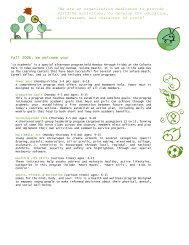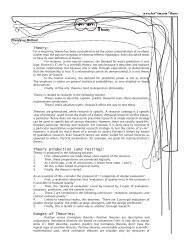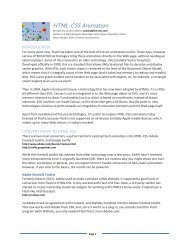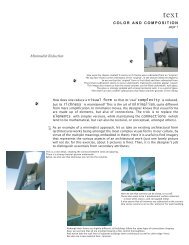ULTRAPERFORMING Beams/ Columns Doors ... - fen-om data
ULTRAPERFORMING Beams/ Columns Doors ... - fen-om data
ULTRAPERFORMING Beams/ Columns Doors ... - fen-om data
Create successful ePaper yourself
Turn your PDF publications into a flip-book with our unique Google optimized e-Paper software.
crowned, beveled, polished, water jet cut, bent, etc. The typical panel size is 4’ x 8’, but cust<strong>om</strong><br />
sizes can be made up to 5’ x 10’. Panel thickness ranges between .030” and 1”.<br />
www.lumicor.c<strong>om</strong>/index.asp<br />
PepCore (CoreTough)<br />
PepCore is a honeyc<strong>om</strong>bed truss-wing-formed c<strong>om</strong>posite wall sandwiched between a seamless,<br />
one-piece, thick outer facing and a thinner inner facing with no rivets required. The PepCore<br />
power structure starts with plastic sheet material like polyethylene, ABS, Surlyn, Polystyrene,<br />
or Polycarbonate. The core material is then formed with Phelps Engineered Plastics proprietary<br />
PepCore process which, through heat and convection, the core sheet is expanded to the desired<br />
honeyc<strong>om</strong>b thickness and ge<strong>om</strong>etry. When mated with the specified facing, it bec<strong>om</strong>es a material<br />
with a high degree of rigidity. PepCore is “pound for pound, lighter than aluminum and stronger<br />
than steel,” and solves the four problems traditionally experienced with traditional aluminum<br />
sheet and post body construction: leakage, rust and corrosion, dents and dings, and weight<br />
management. The lampshade shown above at the far right was designed by Jun Takagi and<br />
manufactured with PepCore material.<br />
www.tss-llc.c<strong>om</strong>/coretoughALpanel.asp<br />
Pervious Concrete<br />
Pervious pavement is a cement-based concrete product that has a porous structure which allows<br />
rainwater to pass directly through the pavement and into the soil naturally. This porosity is<br />
achieved without c<strong>om</strong>pr<strong>om</strong>ising the strength, durability, or integrity of the concrete structure<br />
itself. The pavement is c<strong>om</strong>prised of a special blend of Portland Cement, coarse aggregate rock,<br />
and water. Once dried, the pavement has a porous texture that allows water to drain through<br />
it at the rate of 8 to 12 gallons per minute per square foot. For reference, tests conclude that<br />
a square foot of bahia sod drains at the rate of 2 1/2 to 3 gallons per minute. According to<br />
the manufacturer, this rapid flow-through ratio inspired the phrase “the pavement that drinks<br />
water.”<br />
www.centralconcrete.c<strong>om</strong>/pervious_concrete.html<br />
Self-Structured Sliding <strong>Doors</strong><br />
Traditional Japanese shoji are sliding doors made of washi paper supported by wood crosspieces.<br />
The paper offers privacy and protection fr<strong>om</strong> wind but requires the lattice structure for support.<br />
For the Takeo Corporation’s Haptic exhibition, Japanese architect and materials researcher<br />
Hiroshi Ota set out to rethink the traditional Japanese architectural feature. After researching<br />
the Japanese papermaking technique called kami-suki (paper-scooping), Ota hypothesized that<br />
it would be possible to make self-supporting paper screens. Ota formed a stainless-steel screen<br />
with a dimensional basket weave–type pattern using a rolling press. He molded two sheets of<br />
paper with this screen and attached them together after allowing them to dry. Once paired in this<br />
way, the paper sheets formed a truss capable of supporting its own weight and functioning as<br />
furniture. Although Japanese washi is typically appreciated for its lightness and delicacy, here Ota<br />
has used the paper to create stability and strength in a new sliding door.<br />
http://csur.t.u-tokyo.ac.jp<br />
Super-black<br />
British scientists have invented the darkest material on Earth. The super-black coating was<br />
developed by researchers at the National Physical Laboratory in London. It could revolutionize<br />
optical instruments because it reflects 10 to 20 times less light than the black paint currently<br />
used to reduce unwanted reflections. The key to the nickel and phosphorous coating’s blackness<br />
is that its surface is pitted with microscopic craters. “Super-black” is especially effective at<br />
absorbing light which hits it at an angle. With the light source at right angles, the coating reflects<br />
less than 0.35%. Black paint reflects about 2.5% - seven times more. One of the early applications<br />
might be on startrackers, navigational aids which help spacecraft stay on course by fixing on<br />
pinpricks of light in the heavens. The material could also be used in works of art. NPL says several<br />
artists have shown an interest. Nigel Fox, who heads the optics group at NPL, said: “When you<br />
look at the black, it is an incredibly beautiful surface. It’s like black velvet.”<br />
www.npl.co.uk/optical_radiation/superblack.html<br />
Topo Table<br />
TOPO is a series of Corian tables with built-in reconfigurable landscapes. Plastic inserts drop<br />
into the table to create functional topographies. TOPO uses rapid-prototyping technology in a<br />
way that enables each table to be different, and cust<strong>om</strong>ers color in the areas where they want








